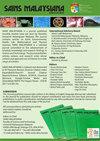水稻淹水和饱和土壤条件下萌前除草剂对杂草水稻的抑制作用
IF 0.7
4区 综合性期刊
Q3 MULTIDISCIPLINARY SCIENCES
引用次数: 0
摘要
由于杂草稻与栽培稻的基因相似,因此选择性除草剂在控制杂草稻的同时又不会对栽培稻造成伤害,因此杂草稻给水稻种植带来了严峻的挑战。在水稻播种前使用萌发前除草剂来抑制杂草稻苗在土壤中萌发和生长的可能性仍是未知数。因此,本研究旨在评估杂草水稻在不同土壤水分条件下对所选萌芽前除草剂的反应,并确定在玻璃温室条件下向土壤施用萌芽前除草剂后播种水稻的最佳时机。结果表明,与戊唑醇相比,施用 500 g ai ha-1 的噁草松和丙草胺对杂草稻密度和干重的降低幅度更大。在饱和土壤条件下,噁唑草酮能减少 79% 和 80% 的杂草密度和干重,而丙草胺能减少 50% 和 59% 的杂草密度和干重。相比之下,在淹水土壤条件下,唑草酮和前草胺都能完全抑制杂草稻。研究表明,在施用前草胺或唑草酮后,水稻种子播种时间至少推迟六天,可有效减少对水稻的植物毒性影响。这些发现为在直播水稻系统中施用前草胺和氧化乐果以有效控制杂草水稻时土壤水分条件的影响提供了有价值的见解。本文章由计算机程序翻译,如有差异,请以英文原文为准。
Inhibition of Pre-Emergent Herbicide on Weedy Rice under Flooded and Saturated Soil Conditions in Rice
Weedy rice poses a formidable challenge in rice cultivation due to its genetic similarity to cultivated rice, making selective herbicides less effective in controlling it without causing harm to the cultivated rice. The potential use of pre-emergent herbicides before rice sowing to inhibit emergence and growth of weedy rice seedlings in the soil remain unknown. Thus, this study aimed to evaluate the responses of weedy rice towards selected pre-emergent herbicides under different soil water conditions and to identify the optimal timing for rice seed sowing following the application of pre-emergent herbicide to the soil under glasshouse conditions. The results showed that oxadiazon and pretilachlor at 500 g ai ha-1 exhibited higher reductions in weedy rice density and dry weight compared to those given by pendimethalin. Under saturated soil conditions, oxadiazon demonstrated 79 and 80% reductions whereas pretilachlor gave 50 and 59% reductions in weedy rice density and dry weight, respectively. By contrast, under flooded soil conditions both oxadiazon and pretilachlor resulted in complete inhibition of weedy rice. The study showed that delaying rice seed sowing for at least six days after application of pretilachlor or oxadiazon effectively minimized phytotoxic effects on rice. These findings provide valuable insights on the impact of soil water conditions when applying pretilachlor and oxadiazon for effective weedy rice control in direct-seeded rice systems.
求助全文
通过发布文献求助,成功后即可免费获取论文全文。
去求助
来源期刊

Sains Malaysiana
MULTIDISCIPLINARY SCIENCES-
CiteScore
1.60
自引率
12.50%
发文量
196
审稿时长
3-6 weeks
期刊介绍:
Sains Malaysiana is a refereed journal committed to the advancement of scholarly knowledge and research findings of the several branches of science and technology. It contains articles on Earth Sciences, Health Sciences, Life Sciences, Mathematical Sciences and Physical Sciences. The journal publishes articles, reviews, and research notes whose content and approach are of interest to a wide range of scholars. Sains Malaysiana is published by the UKM Press an its autonomous Editorial Board are drawn from the Faculty of Science and Technology, Universiti Kebangsaan Malaysia. In addition, distinguished scholars from local and foreign universities are appointed to serve as advisory board members and referees.
 求助内容:
求助内容: 应助结果提醒方式:
应助结果提醒方式:


